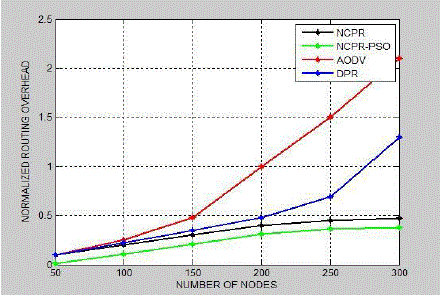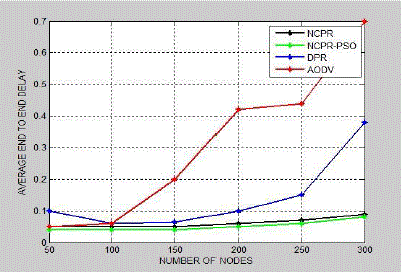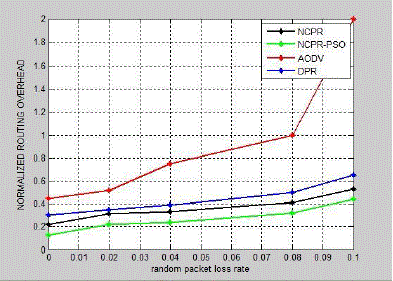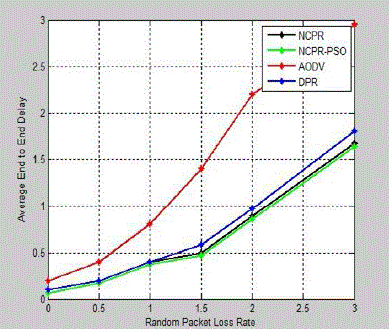Keywords
|
| NCPR- neighbourhood coverage based probabilistic rebroadcast, PSO- Particle Swarm Optimization. |
INTRODUCTION
|
| Mobile Ad hoc Networks is formed by several independent wireless mobile nodes. These nodes act as router as well as host. MANET is a self configuring network. Dynamic topology, decentralized network are certain features of MANET. MANET is useful in areas where connections are not possible as in case of disaster prone areas, military areas, and several medical areas [1]. In MANET, the nodes are connected through radio waves. Due to limited range of transmission, the packets are routed from multiple hops while sending from sender to receiver. |
| Routing is an important aspect. There are two types of routing protocols for MANET: [2,3] |
| (1) Proactive routing protocol |
| (2) Reactive routing protocol |
| The paths formed by these protocols can be unipath or multipath. Multipath routing protocols are better than unipath protocols because if there is a link breakage there could be another path to be followed. Probability of link breakage is more because of the dynamic topology of nodes. So it is very difficult to maintain QoS. Several architectures like DACME ( Distributed Admission Control for MANET environments) has been proposed [4]. |
| Most of the routing protocols for MANETs, such as AODV [5], DSR [6], do not consider the QoS for the routes they generate. These protocols will not give good results in real time applications. Considering QoS in real time applications is an important aspect. Routing overhead in broadcasting a request degrades the performance of a network. Periodic hello messages and rebroadcasting of a request due to link breakages are of two major causes of increased routing overhead. Here we discuss a QoS multipath routing protocol: NCPR which avoids the use of hello messages, works on the neighbor knowledge[7]. Firstly a rebroadcast order is found, then by calculating the number of neighbors covered, additional coverage ratio is found. A connectivity factor is calculated and it together with additional coverage ratio gives a probability to rebroadcast. |
RELATED WORK
|
| In dynamic networks where topology changes frequently, routing overhead incurred because of broadcasting could be extremely high. Controlling the routing overhead in order to optimize broadcasting is a major concern. |
| Ni et al[8] showed the costly nature of rebroadcasting and excessive consumption of network resources. Several problems like collisions, redundant retransmissions occur as a result of broadcasting. |
| Ould – Khaoua[9] proposed Adjusted Probabilistic route discovery (AP) and Enhance adjusted probabilistic route discovery(EAP). AP and EAP are probabilistic methods for discovering the route. Local density of the sender node helps calculating the forwarding probability. Forwarding probability is set high if location of nodes is in less dense area, while it is set to low if the density is high. |
| Peng and Lu[10] proposed a Scalable Broadcast algorithm(SBA), which is a neighbor knowledge scheme which considers the fact ‘ whether the rebroadcast would reach additional nodes’ for rebroadcasting a packet. |
| Huang[11] proposed a concept of adjusting the hello timer and the time out timer dynamically according to the mobility of network. Zhang[12] proposed the concept of combining the neighbor coverage and probabilistic mechanism to reduce routing overhead. |
PROPOSED NCPR-PSO SCHEME
|
| Motivation of the protocol comes from the need to optimize broadcasting. In this section we combine the advantages of two mechanisms: a) neighbour coverage knowledge |
| b) Probabilistic mechanism |
| The main objectives of this protocol are: |
| 1) To reduce the routing overhead caused by the hello packets |
| 2) To reduce the overhead of rebroadcasting |
| The protocol is divided into following sections: |
| 1) To calculate uncovered neighbor set and delay in rebroadcasting the packet. |
| 2) Calculate precisely the neighbor knowledge and rebroadcast probability. |
| 3) Broadcast according to the pso_fit value.[13][14] |
| UCN set and Rebroadcast delay |
| Let a node s send a RREQ packet to another node ni, node ni will check its common neighbours with the nodes mentioned in the RREQ packet to determine the uncovered neighbours. Node ni calculates the uncovered neighbour set as: |
 |
| Here neigh (ni)= neighbour set of node ni. |
| Neigh(s) = neighbour set of node s. |
| {s}= node which sends the request packet to node ni. |
| After calculating the UCN the rebroadcast delay is calculated. Rebroadcast delay determines the forwarding order of nodes. The node with the lowest delay will have more common neighbours and hence will have a higher probability to rebroadcast the RREQ. |
| Rebroadcast delay( R.D.)= Delay ratio(DR)* MAX DELAY |
 |
| MAX DELAY is a small constant delay. |
| count[neigh(ni)∩neigh(s)] is the number of elements which are common in the neighbour set of ni and neighbour set of s. |
| The node which will have the lowest delay has higher probability to rebroadcast the RREQ packet. The rebroadcast probability is calculated in the next section. The node sets a timer according to the rebroadcast delay. |
| Rebroadcast probability: |
| Before the timer expires if node ni receives a duplicate request from a node nj then node ni will further adjust its UCN(ni) as follows: |
 |
| Where neigh(nj) is the number of neighbours of node nj. |
| After adjusting the UCN(ni) the RREQ packet from nj is sent to the fitness function of PSO. If the pso_fit function discards the acceptance of the packet then the packet is completely rejected. |
| If the timer expires the rebroadcast probability is calculated according to the additional coverage ratio and the connectivity factor of node ni |
 |
| Pre(ni) is the rebroadcast probability. |
| Fc(ni) is the connectivity factor. |
| Ra(ni) is the additional coverage ratio. |
 |
| Additional coverage ratio is defined as the ratio of count of nodes in the final uncovered neighbour set of ni and the count of number of neighbours of node ni. |
| The RREQ packet needs to be processed by these additionally covered nodes. As Ra increases, rebroadcast probability is set higher as the rebroadcast will cover more number of nodes. |
| Connectivity factor defines the number of neighbours of a particular node. |
 |
| Where Nc=5.1774 logn |
| N refers to the number of nodes in the network. |
| The rebroadcast probability calculated is compared with the value generated by the pso_fit function. If Pre is more than the pso_fit value then it is broadcasted. |
PERFORMANCE EVALUATION
|
Simulation model and parameters
|
| We have used MATLAB for simulation of our protocol. In our simulation 20 to 300 mobile nodes move randomly n a 1000*1000 square meter area. We assume that each node move at a speed ranging between 1m/s to 5m/s. |
| Each node has a transmission range of 250m. The simulated traffic is constant bit rate (CBR). |
| Performance metrics used for evaluation are: normalized routing overhead and average end to end delay. |
| ïÃâ÷ Performance with varied number of nodes. |
| Fig 1 shows the behaviour of normalized routing overhead with increasing number of nodes. On an average the overhead is reduced by 9 percent in NCPR-PSO when compared with NCPR. Figure shows the normalized routing overhead with varying network density. The NCPR-PSO protocol reduces the routing overhead which occurs during the route discovery process. NCPR-PSO protocol increases the packet size of RREQ packets, but it also reduces the number of RREQ packets. As a result there is a significant decrease in routing overhead. |
| Fig 2 shows the results of average end to end delay with increasing network density. Average end to end delay is decreased using NCPR-PSO by1.2 percent in comparison to NCPR. The NCPR protocol decreases the average end-to-end delay due to a decrease in the number of redundant rebroadcast packets. The pso_fit function helps to find the optimal solution to forward the packet due to which chances of rebroadcast reduce a lot. Hence there is a decrease in delay as compared to NCPR,AODV and DPR. |
| ïÃâ÷ Performance with varied Random Packet Loss Rate |
| Fig 3 shows the plot of random packet loss rate with normalized routing overhead. The normalized routing overhead is being decreased by 9 percent as compared to NCPR. Normalized routing overhead is the ratio of total packet size of control packets to the total packet size of data packets delivered to the destination. The packet loss increases as a result of link breakages, therefore there is a requirement of new route discoveries, which will lead to increased routing overhead NCPR-PSO reduces redundant rebroadcast as compared to NCPR, DPR and AODV. As a result it incurs less routing overhead as compared to NCPR. |
| Fig 4 shows the comparison of random packet loss rate with average end to end delay. The average end to end delay is improved b 1 Percent as compared to NCPR.As a result of increased packet loss, there is an increase in the retransmissions caused by random packet loss at MAC layer which will increase the average end to end delay. Both NCPR-PSO and NCPR reduces the retransmissions caused by collisions at MAC layer as compared to DPR and AODV. |
CONCLUSION
|
| In this paper, we proposed a PSO based rebroadcast protocol based on probability and neighbour coverage in MANETs. The PSO is used to calculate the fit value. Neighbour coverage knowledge helps to calculate the rebroadcast delay which is calculated using additional coverage ratio and connectivity factor. The results of simulation show an improvement because of less redundant rebroadcast and the broadcast of the best fit value. Simulation results show an increase in packet delivery ratio and decrease in average end to end delay. |
Tables at a glance
|
 |
| Table 1 |
|
| |
Figures at a glance
|
 |
 |
 |
 |
| Figure 1 |
Figure 2 |
Figure 3 |
Figure 4 |
|
| |
References
|
- PravinGhosekar, GirishKatakar, PradipGhorpade, “Mobile Ad Hoc Networking: Imperatives and Challenges”, IJCA special issue on “Mobile ad hoc networks” ,MANETs 2010
- Ipsita Panda “A Survey on Routing Protocols of MANETs by Using QoS Metrics ” International journal of advanced Research in computerscience and software engineering, volume2, October 2012
- Coroson S, Macker J, “Mobile Ad hoc Networking (MANET) Routing Protocol Performance Issues and Evaluation Considerations rfc 2501”,January 1999.
- C.T. Calafate, J. Oliver et.al., “QoS Support in MANETs: A Modular Architecture Based on the IEEE 802.11e Technology”, IEEETransactions On Circuits and Systems for Video Technology, Vol 19, No 5, May 2009
- NeerjaKhatri and Arvind Kumar, “Analysing Performance of AODV Routing protocol in mobile Ad-hoc networks: A survey”, InternationalJournal of Engineering Research and Technology, vol1,issue3, pp:1-5, May 2012
- G.Lavanya and A. Ebenezer Jeyakumar, “ An Enhanced Secured Dynamic Source Routing Protocols for MANETs”, International Journal ofSoft Computing and Engineering, vol X, pp:135-140, September 2011
- J. Kim, Q. Zhang, and D.P. Agrawal, “Probabilistic Broadcasting Based on Coverage Area and Neighbor Confirmation in Mobile Ad HocNetworks,” Proc. IEEE GlobeCom, 2004.
- S.Y. Ni, Y.C. Tseng, Y.S. Chen, and J.P. Sheu, “The Broadcast Storm Problem in a Mobile Ad Hoc Network,” Proc. ACM/IEEE MobiCom,pp. 151-162, 1999
- X.Wu, H.R. Sadjadpour, and J.J. Garcia-Luna-Aceves, “Routing Overhead as a Function of Node mobility: Modeling Framework andImplications and Proactive Routing,” Proc. Of IEEE MASS’07,pp.1-9,2007
- W. Peng and X. Lu, “On the Reduction of Broadcast Redundancy in Mobile Ad Hoc Networks,” Proc. ACM MobiHoc ,pp.129-130,2000.
- D.Johnson, Y.Hu, and D.Maltz, “The dynamic source routing protocol for mobile Ad Hoc Networks(DSR) for IPV4,” RFC 4728,2007.
- Zhang et.al., “ Neighbor coverage based probabilistic rebroadcast for reducing routing overhead in Mobile Ad hoc Networks”,IEEEtransactions on mobile computing, vol12, No3, Mach 2013
- G. Venter, and J. Sobieszczanski-Sobieski, “Particle Swarm Optimization”, Proceedings of the 43rd AIAA/ASME/ASCE /ASC Structures,Structural Dynamics and Materials Conference, Denver, Co. 2002.
- E. Baburaj, and V. Vasudevan “An Intelligent Mesh Based Multicast Routing Algorithm for MANETs using Particle Swarm Optimization”,IJCSNS International Journal of Computer Science and Network Security, VOL.8 No.5, pp:214-218, May 2008.
|